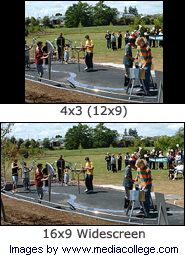Why Go Widescreen?

As the television world makes the transition from the traditional 4:3 format to 16:9 wide-screen, many people ask "Why? What's Wrong with 4:3? Should I convert to widescreen?".
These are valid questions for both programme makers at one end and viewers at the other end.
- Producers and broadcasters need to decide whether to make the difficult and expensive transition to widescreen.
- Viewers need to decide whether to upgrade their 4:3 TV set to widescreen.
We will attempt to answer this question from both points of view. However we should point out that in the long run there is one simple fact which overrides all other arguments: Widescreen is the new standard and everyone will eventually be using it whether they like it or not. Whilst some people will hold on to 4:3 as long as they can, the future of widescreen is inevitable. The real question is not "Should I go widescreen?" but "Should I go widescreen now, or should I wait?".
First of all, let's ask some general questions.
Is Widescreen Better than 4:3?
Although it's a subjective question and there may never be 100% agreement, the answer is widely accepted as being yes. Widescreen is considered to be a more natural view for humans, more closely simulating the way we see the world than the "tunnel vision" view of 4:3.
When Will Widescreen Become the Dominant Format?
This depends largely on where in the world you live. You should ask your local dealers and follow retail trends in your country. Widescreen is already the format of choice in most developed countries. By 2010, 4:3 will probably appear quite outdated.
Now let's consider the people who make and broadcast TV programmes.
Why Produce Widescreen Programmes?
For television production companies, it is very difficult and expensive converting from traditional formats to widescreen. However the inevitability of widescreen means that the move must be made sooner or later. Large producers with large budgets will be making the move soon (if they haven't done it already), smaller producers may hold out longer but will eventually be forced to make the move or face redundancy.
In addition to this commercial reality, there are several reasons to create widescreen programming:
- The widescreen format is destined to become the preferred choice of most viewers. Programmes will be more popular in widescreen and retain value longer.
- Creating television programmes in essentially the same format as theatrical release films makes it easier to transfer from one medium to the other.
- Many types of programme will benefit from the extra screen space, not just feature films. For example, many sports are well-suited to widescreen.
- Widescreen provides more options for split-screen images; for example, two simultaneous camera views or devoting part of the screen to graphics.
In the end, producers will create widescreen content for the simple reason that the market will demand it. This brings us to the consumers...
Why Buy a Widescreen TV?
This decision will depend mainly on three things:
Do You Actually Need a New TV?
Are you buying a TV and trying to decide which format to go with, or are you deciding between keeping your current TV and upgrading?
If you are happy enough with your current TV, there is no urgency to upgrade. Television producers know that 4:3 sets will be around for many years and they need to be catered for.
If you are tossing up between 4:3 and widescreen for your new TV, we recommend widescreen unless you have some specific reason to buy 4:3. Televisions are a relatively long-term investment and your new TV will still be young when widescreen becomes the dominant format.
What do you watch, and what is available in widescreen?
If you watch a lot of DVDs, especially feature films, you'll certainly be interested in widescreen. Whereas VHS movies are usually optimised for 4:3 TVs, DVDs are generally optimised for widescreen viewing.
For television programmes, you'll want to know what widescreen options are available in your area. Most developed countries broadcast at least some widescreen content, but if most of the programmes you watch are still 4:3 you may actually find widescreen less enjoyable.
What Are Prices Like?
If there is still a significant price difference between formats in your area, this may be a significant factor in your decision.
Conclusion
We acknowledge that there are differing opinions on this topic, but in our opinion:
- If you are in the business of making video and television programmes, you should either be using widescreen already or planning for it.
- For most consumers, there is no particular hurry to buy a widescreen TV. However if you are about to buy a new TV anyway then you should probably go for a widescreen if possible.
Comments or questions about this page? Visit our forums.